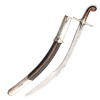How are barrels choked?
Years ago, chokes were put into barrels with reamers just before they were rifled. In other words, the choke was cut directly into the metal of the bore. But with the advent of button- and broach-rifling, it’s easier to rifle the barrel first and then squeeze it down afterwards.
I read with interest where one of our readers was advising someone that a barrel had to be annealed before choking it by the squeezing method, and then hardened afterward. Actually, air rifle and rimfire barrels are made from dead soft steel, or steel that is nearly dead soft. They are not hardened in any way and can be distorted very easily. You could choke a barrel by tapping the outside with a ball peen hammer — though it won’t be uniform, and I certainly don’t recommend trying it.
Chokes can be rolled into barrels with hardened steel rollers set in fixtures that apply force gradually. Someone asked if a tubing cutter would work for this, and I have the answer. No, it won’t work. It will crimp the barrel, but it’s too sloppy and difficult to control a hand tool like a tubing cutter. I know this because I had Dennis Quackenbush convert a tubing cutter for me several years ago, and I attempted to choke barrels this way. But a precision jig that applies equal force to precision rollers that are similar to the function of a tubing cutter is certainly one good way to choke a rifle barrel.
Another way is to run the barrel straight into a tapered die and swage in the choke — similar to resizing a cartridge during reloading, only a lot more force is required. To do it that way requires that the outside of the barrel be held to very close tolerances, so it’s less desirable than the tapered roller method.
A third way to choke a barrel is to squeeze it together from the outside, using a die made in two pieces. The pieces come together, compressing the barrel between them. Like the other method that uses a die, this method also requires a barrel of a given outside diameter.
If you hammer-forge the barrel (cold-forming the barrel around a hardened mandrel that has the rifling pattern in reverse), the choking can be done when the mandrel is made. Simply make the mandrel with a taper, and the barrel that’s ironed around it will also be tapered.
Companies select the method of choking that suits their barrel manufacturing methods. In other words, if they make hammer-forged barrels, that’s the most convenient time to put in the choke. But if they sell only one choked barrel for every thousand barrels they make, rolling in the choke probably makes more sense.









